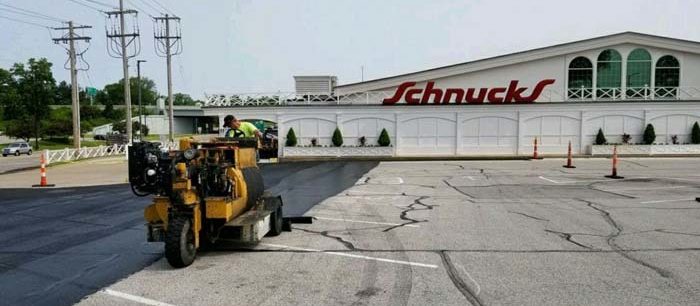Get This Report about A1 Professional Asphalt & Sealing Llc
Get This Report about A1 Professional Asphalt & Sealing Llc
Blog Article
The Ultimate Guide To A1 Professional Asphalt & Sealing Llc
Table of ContentsThe 9-Minute Rule for A1 Professional Asphalt & Sealing LlcMore About A1 Professional Asphalt & Sealing LlcAll About A1 Professional Asphalt & Sealing LlcNot known Facts About A1 Professional Asphalt & Sealing LlcThe 9-Second Trick For A1 Professional Asphalt & Sealing Llc

The oil in a car engine is not simply oil. It contains a variety of ingredients to improve the automobile's efficiency. These include polymers, thickness modifiers, warm stabilizers, additional lubricating substances, and use additives. The REOB includes all the ingredients that were in the waste oil along with the wear metals from the engine (mainly iron and copper).
Nonetheless, by making several blends utilizing various REOB samples and different asphalt binders, the variations greatly can be averaged out. Numerous States offered samples of well-known REOB composition to TFHRC researchers, that analyzed the samples to compare the percentage of added (understood) REOB to the found (checked) amount. The evaluations showed an equivalent percentage of included and found REOB.
The Best Guide To A1 Professional Asphalt & Sealing Llc
None of those States recognized that the asphalt they were buying contained REOB. One State insisted its examples had no REOB - https://www.find-us-here.com/businesses/A1-Professional-Asphalt-Sealing-LLC-Lebanon-Illinois-USA/34044537/.
Of the 1,532 samples examined, 12 percent consisted of REOB, and some had substantially high levels of it at 1020 percent. The highest possible degree was 34 percent in an example from Texas, which TxDOT had actually made use of in a patching compound. This testing likewise disclosed the presence of phosphoric acid in 11 percent of the examples, and 2 percent contained ground tire rubber.
Two years back at TRB's annual conference, the Federal scientists held an REOB workshop and offered the searchings for of their research laboratory examinations to a standing room-only crowd. Some companies do not especially outlaw REOB, they do enforce physical examinations that avert its useeffectively a restriction. Others do not ban it by specification, but have arrangements with asphalt suppliers to prevent the usage of REOB
The Facts About A1 Professional Asphalt & Sealing Llc Uncovered
A handful do allow REOB, some within specific restrictions. As an example, Ohio and Texas limit levels to much less than 5 percent of the asphalt. To develop a reputable examination technique that all States can utilize, the TFHRC researchers established a round-robin test strategy. The participants are 11 State freeway companies (Illinois, Massachusetts, Minnesota, Mississippi, Montana, North Carolina, Oklahoma, South Carolina, Texas, Vermont, and Wyoming), 2 independent Visit Website screening laboratories, the Ministry of Transportation in Ontario, Queen's University in Ontario, and an Ontario paving professional.
In overall, the scientists prepared and delivered 720 blends. The individuals are testing the samples independently utilizing the standards offered by the TFHRC researchers. The round-robin screening is nearly finished, and TFHRC is in the process of accumulating the results. The output will certainly be a suggested AASHTO examination approach that any kind of State can embrace and utilize (a1 professional).
The pavement with REOB, which lies 0.6 mile (1 kilometer) from the sidewalk without REOB, has the same subgrade, traffic density, and environment. However, the segment of Highway655 with 5 to 10 percent REOB showed substantial cracking. In this instance, the visibility of REOB was the recognized reason of splitting at a reduced temperatures.
An area of examination sidewalk in Minnesota (MN1-4) located to have REOB additionally fractured prematurely. The sidewalk done well for the initial 3 to 4 years, however then began to break.
Some Known Questions About A1 Professional Asphalt & Sealing Llc.
The examinations were not substantial, but they showed that at levels of 6 percent or more, the tensile strength of the asphalt went down considerably. At a degree of 3.5 percent REOB, the variant in the physical test methods was above the result of REOB. It was challenging for researchers to examine whether REOB was existing. https://zzri1z2o90l.typeform.com/to/BPqH2MM1.

One binder criterion thought about is the distinction between the low temperature level important specification temperature for tightness (S) in the bending beam of light rheometer and the flexing light beam rheometer creep slope (m-value) noted as Tcritical. TC = TC (S) TC (m-value). Examination of this criterion is still continuous. 2 independent study groups, one from AASHTO and the other from the Asphalt Institute, ended that even more study is required on using REOB in asphalt.
Formerly, all asphalt testing determined design properties such as rigidity. These examinations do not reveal what products had been added to the asphalt. One sample obtained throughout the TFHRC research had a really strange evaluation. The example had the following test outcomes: Superpave PG 64-28 with a high temperature grade of 67.3 Tcritical on the bending light beam rheometer was 6.7 levels Celsius.

Rumored Buzz on A1 Professional Asphalt & Sealing Llc
These outcomes show there are weaknesses in the standardized engineering testing protocols that may be exploited. The producer might have a financial advantage and the item passes all the standardized tests, but the item might not be valuable to ensuring long-term performance. To resolve this issue and the expansion of brand-new asphalt additives and extenders, TFHRC is beginning a research program to use handheld spectroscopic tools, x-ray fluorescence spectroscopy, and Fourier change infrared spectroscopy to allow analyses to be carried out in the field as opposed to needing to take examples back to the laboratory.
Report this page